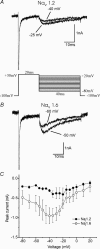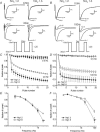Electrophysiological properties of two axonal sodium channels, Nav1.2 and Nav1.6, expressed in mouse spinal sensory neurones
- PMID: 15760941
- PMCID: PMC1464456
- DOI: 10.1113/jphysiol.2005.083089
Electrophysiological properties of two axonal sodium channels, Nav1.2 and Nav1.6, expressed in mouse spinal sensory neurones
Abstract
Sodium channels Na(v)1.2 and Na(v)1.6 are both normally expressed along premyelinated and myelinated axons at different stages of maturation and are also expressed in a subset of demyelinated axons, where coexpression of Na(v)1.6 together with the Na(+)/Ca(2+) exchanger is associated with axonal injury. It has been difficult to distinguish the currents produced by Na(v)1.2 and Na(v)1.6 in native neurones, and previous studies have not compared these channels within neuronal expression systems. In this study, we have characterized and directly compared Na(v)1.2 and Na(v)1.6 in a mammalian neuronal cell background and demonstrate differences in their properties that may affect neuronal behaviour. The Na(v)1.2 channel displays more depolarized activation and availability properties that may permit conduction of action potentials, even with depolarization. However, Na(v)1.2 channels show a greater accumulation of inactivation at higher frequencies of stimulation (20-100 Hz) than Na(v)1.6 and thus are likely to generate lower frequencies of firing. Na(v)1.6 channels produce a larger persistent current that may play a role in triggering reverse Na(+)/Ca(2+) exchange, which can injure demyelinated axons where Na(v)1.6 and the Na(+)/Ca(2+) exchanger are colocalized, while selective expression of Na(v)1.2 may support action potential electrogenesis, at least at lower frequencies, while producing a smaller persistent current.
Figures






Similar articles
-
Distinct repriming and closed-state inactivation kinetics of Nav1.6 and Nav1.7 sodium channels in mouse spinal sensory neurons.J Physiol. 2003 Sep 15;551(Pt 3):741-50. doi: 10.1113/jphysiol.2003.047357. Epub 2003 Jul 3. J Physiol. 2003. PMID: 12843211 Free PMC article.
-
Contribution of Na(v)1.8 sodium channels to action potential electrogenesis in DRG neurons.J Neurophysiol. 2001 Aug;86(2):629-40. doi: 10.1152/jn.2001.86.2.629. J Neurophysiol. 2001. PMID: 11495938
-
Inactivation properties of sodium channel Nav1.8 maintain action potential amplitude in small DRG neurons in the context of depolarization.Mol Pain. 2007 May 31;3:12. doi: 10.1186/1744-8069-3-12. Mol Pain. 2007. PMID: 17540018 Free PMC article.
-
Neuronal signaling in central nervous system.Sheng Li Xue Bao. 2011 Feb 25;63(1):1-8. Sheng Li Xue Bao. 2011. PMID: 21340428 Review.
-
Autonomic regulation of voltage-gated cardiac ion channels.J Cardiovasc Electrophysiol. 2006 May;17 Suppl 1:S34-S42. doi: 10.1111/j.1540-8167.2006.00387.x. J Cardiovasc Electrophysiol. 2006. PMID: 16686680 Review.
Cited by
-
Sea-anemone toxin ATX-II elicits A-fiber-dependent pain and enhances resurgent and persistent sodium currents in large sensory neurons.Mol Pain. 2012 Sep 15;8:69. doi: 10.1186/1744-8069-8-69. Mol Pain. 2012. PMID: 22978421 Free PMC article. Clinical Trial.
-
Biophysical characterisation of the persistent sodium current of the Nav1.6 neuronal sodium channel: a single-channel analysis.Pflugers Arch. 2010 Jun;460(1):77-86. doi: 10.1007/s00424-010-0801-9. Epub 2010 Mar 5. Pflugers Arch. 2010. PMID: 20204400
-
Need for Speed and Precision: Structural and Functional Specialization in the Cochlear Nucleus of the Avian Auditory System.J Exp Neurosci. 2018 Dec 12;12:1179069518815628. doi: 10.1177/1179069518815628. eCollection 2018. J Exp Neurosci. 2018. PMID: 30559595 Free PMC article. Review.
-
Differential modulation of voltage-gated sodium channels by nerve growth factor in three major subsets of TrkA-expressing nociceptors.Mol Pain. 2018 Jan-Dec;14:1744806918814640. doi: 10.1177/1744806918814640. Epub 2018 Nov 2. Mol Pain. 2018. PMID: 30387376 Free PMC article.
-
Axonal Computations.Front Cell Neurosci. 2019 Sep 18;13:413. doi: 10.3389/fncel.2019.00413. eCollection 2019. Front Cell Neurosci. 2019. PMID: 31619963 Free PMC article. Review.
References
-
- Afshari FS, Ptak K, Khaliq ZM, Grieco TM, Slater NT, McCrimmon DR, Raman IM. Resurgent Na currents in four classes of neurons of the cerebellum. J Neurophysiol. 2004;92:2831–2843. 10.1152/jn.00261.2004. - DOI - PubMed
-
- Akopian AN, Souslova V, England S, Okuse K, Ogata N, Ure J, Smith A, Kerr BJ, McMahon SB, Boyce S, Hill R, Stanfa LC, Dickenson AH, Wood JN. The tetrodotoxin-resistant sodium channel SNS has a specialized function in pain pathways. Nat Neurosci. 1999;2:541–548. 10.1038/9195. - DOI - PubMed
-
- Baker MD, Bostock H. Low-threshold, persistent sodium current in rat large dorsal root ganglion neurons in culture. J Neurophysiol. 1997;77:1503–1513. - PubMed
-
- Black JA, Dib-Hajj S, McNabola K, Jeste S, Rizzo MA, Kocsis JD, Waxman SG. Spinal sensory neurons express multiple sodium channel alpha-subunit mRNAs. Mol Brain Res. 1996;43:117–131. - PubMed
-
- Black JA, Renganathan M, Waxman SG. Sodium channel Nav1.6 is expressed along nonmyelinated axons and it contributes to conduction. Mol Brain Res. 2002;105:19–28. - PubMed
Publication types
MeSH terms
Substances
LinkOut - more resources
Full Text Sources
Other Literature Sources
Miscellaneous

